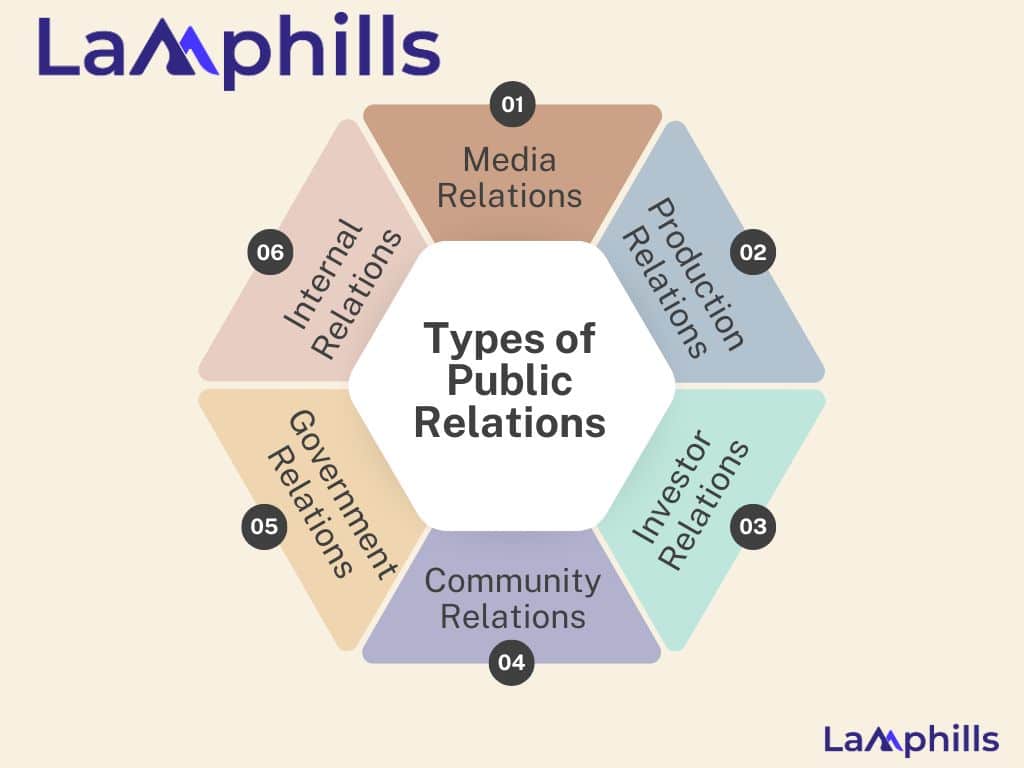Some brands effortlessly capture the public’s attention, create a loyal following, and maintain a stellar reputation. The secret often lies in the strategic world of public relations (P.R.). P.R. is more than just managing a company’s image. It’s about building meaningful relationships, fostering trust, and communicating effectively with diverse audiences. But what exactly are the objectives that drive successful public relations campaigns? Join me as we explore the public relations objectives and showcase real-world examples. You won’t want to miss it!
Key Points
- P.R. is essential for managing a company’s image, building meaningful relationships, fostering trust, and effectively communicating with diverse audiences.
- P.R. involves raising awareness and creating positive images through stories and articles in the media.
- PR departments or agencies focus on areas such as media, production, investor, internal, government, community, and customer relations.
- Key objectives include controlling the narrative, building trust and credibility, maintaining a positive image, fostering media relationships, increasing awareness, educating and modifying perceptions, managing publicity, preparing spokespeople, and ensuring stakeholder communication.
- P.R. professionals use various strategies, such as arranging interviews, writing press releases, utilizing social media, building strong media relationships, effective communication through events and meetings, and creating positive perceptions.
What is Public Relations?
Public relations (PR) is about creating and maintaining a positive image for an organization or product by communicating effectively with the public. This involves using various communication channels and tools to build good relationships with key audiences.
In the past, PR professionals mainly worked with journalists to get positive stories about their organization or product into newspapers and on TV. However, today’s P.R. work is much broader and includes:
- Raising awareness and creating a positive image through stories and articles in relevant media.
- Monitor different media channels to see what people say about the company and its products.
- Managing crises that could harm the company’s or product’s image.
- Building goodwill among target audiences through community involvement, charitable activities, and special events.
In essence, PR is about managing the flow of information from an individual or company to the public, aiming to highlight positive news and minimize the impact of any adverse events. This can be done through press releases, news conferences, interviews, social media posts, and more. Everyone who operates in the public eye engages in some form of PR to shape how others perceive them.
Understanding Public Relations (P.R.)
Public relations (PR) often presents a person, company, or brand in the best possible light. While PR might be associated with “spin,” its primary goal is to create a positive image that seems natural. Unlike advertising, which is paid for, P.R. aims to generate good publicity through independent sources, making it look organic and credible. It also involves advising businesses on decisions that will gain public support.
P.R. was clearly defined in the mid-20th century. Still, it’s one of the fastest-growing industries in the U.S. P.R. is crucial for any company’s success, especially for those with publicly traded shares, as the value of shares depends on public confidence in the company or brand.
P.R. professionals handle media requests, answer questions, and address shareholder concerns. They are also responsible for creating and maintaining the company’s image. Sometimes, PR may involve negative tactics to harm a competitor’s reputation, which is generally against the industry’s ethical standards.

Types of Public Relations
Public relations (PR) involves different departments or agencies, each specializing in specific areas:
#1. Media Relations
Our Media Relations service is guided by a comprehensive knowledge of the constantly changing media industry and an extensive network of influential journalists, bloggers, and thought leaders across various platforms. We prioritize building strong, enduring relationships with our clients based on trust, expertise, and a mutual dedication to producing top-notch, influential content.
To manage your social media, check out this checklist
Using thoughtfully selected media placements, focused outreach campaigns, and strategic collaborations, we guarantee that your brand’s narrative will effectively reach its intended audience precisely when it matters most. We create impactful media materials, such as pitches and thought leadership content. Our team of experts ensures that these materials are engaging and resonate with your target audience, establishing your brand as a trusted authority in your industry. Contact us
#2. Production Relations
This department manages the company’s direct operations and supports marketing plans. It often involves one-time events like product launches, unique campaigns, or managing significant product changes.
#3. Investor Relations
This area oversees the company’s relationship with its investors. It organizes investor events, communicates financial reports, and addresses investor concerns.
#4. Internal Relations
This branch manages the company’s relationship with its employees. It counsels employees, ensures satisfaction with working conditions, and mediates internal issues to prevent public disclosure of dissatisfaction.
#5. Government Relations
This department handles the relationship between the company and governing bodies. Its goals are to provide feedback to politicians, influence decision-makers, and ensure the fair treatment of the company’s clients.
#6. Community Relations
This focuses on the company’s brand and reputation within a specific community, whether physical (like a city) or non-physical (like a dog-owner community). It aligns with the community’s social niche to connect with its members.
#7. Customer Relations
This department bridges the gap between the company and its customers. It manages key relationships, conducts market research, understands customer priorities, and addresses significant concerns to maintain positive customer relationships.
Also, read: Building an Effective Crisis Management Plan for Your Business
Public Relations Objectives

Credit: pressfoto
#1. Controlling the Narrative
PR professionals strategically manage how information is presented to the public, especially during crises. They work to mitigate damage, restore confidence, and ensure the organization’s message is accurately conveyed.
#2. Building Trust and Credibility
In an era where skepticism towards traditional advertising is high, PR provides a more authentic way to connect with the public. By promoting transparency, honesty, and integrity, PR helps establish trust and credibility for the organization.
#3. Maintaining a Positive Image
PR efforts focus on showcasing the organization’s positive actions, values, and achievements. By highlighting its social responsibility initiatives, commitment to transparency, and prosperous endeavors, PR helps shape a favorable public perception.
#4. Fostering Media Relationships
PR professionals cultivate strong relationships with journalists and media outlets. By providing accurate information, timely responses, and access to key personnel, PR ensures the organization’s story is portrayed accurately and positively in the media.
#5. Increasing Awareness
PR utilizes various channels, such as earned media coverage, social media, and owned content, to increase visibility and awareness of the organization among its target audience.
#6. Educating and Modifying Perceptions
PR seeks to inform the public about the organization’s values, products, and services. By addressing misconceptions and shaping perceptions through strategic messaging, PR helps influence public opinion.
#7. Managing Publicity
PR aims to generate positive publicity while minimizing negative coverage. This involves proactive media outreach, crisis management, and reputation repair strategies.
#8. Preparing Spokespeople
PR trains vital personnel, such as executives and spokespersons, to effectively represent the organization in media interviews, press conferences, and public appearances. This ensures consistent messaging and enhances the organization’s credibility.
#9. Stakeholder Communication
PR maintains open lines of communication with stakeholders, including employees, investors, customers, and community members. By keeping them informed and engaged, PR fosters trust and loyalty.
#10. Strategic Work
PR professionals develop and execute strategic plans to achieve the organization’s communication goals. This involves researching, analyzing data, and adapting strategies to changing circumstances to maximize effectiveness.
#11. Building Product Awareness
PR can create consumer attention and awareness when launching a new product or reintroducing an existing one. This is achieved through media placements and special events that showcase the product.
#12. Creating Interest
PR placements in the media, such as product articles or features in roundup pieces, can spark interest among targeted audiences. For example, special holiday foods might be promoted during the holiday season through PR efforts like sending promotional releases to food media or hosting sampling events.
#13. Providing Information
PR delivers more detailed information about products and services to customers through articles, brochures, newsletters, and websites, helping customers better understand the product.
#14. Stimulating Demand
Positive coverage in newspapers, TV news shows, or online platforms often increases product sales. PR plays a significant role in generating this kind of positive exposure.
#15. Reinforcing the Brand
PR also contributes to brand reinforcement by maintaining positive relationships with key audiences. A strong brand image is essential for business success, helping companies weather crises and build customer trust.
These objectives help PR professionals navigate the complex landscape of public perception, ensuring the organization maintains a positive image, fosters trust, and effectively communicates its message to key stakeholders.
You might want to check out this Press Release Email Template
How to Achieve Public Relations Objectives

Credit: pressfoto
To achieve Public Relations Objectives, PR professionals use several strategies and tactics. Here’s how they do it:
- Raising Awareness: PR professionals work with the media to share information that the public will find interesting. They arrange interviews, write press releases, and pitch story ideas to journalists. Additionally, they use social media to share information and engage with audiences, although social media marketing often falls under digital marketing.
- Building Relationships: A key PR objective is developing strong relationships with media members so they are more likely to cover the organization’s stories. PR professionals also interact with key stakeholders and important audiences through events, meetings, and conversations.
- Communication: Effective communication is at the heart of PR. While media coverage is crucial, other activities like events, special meetings, and conversations also help achieve this objective by reaching different audiences in various ways.
- Creating Positive Perceptions: PR ensures that all communications are consistent and accurate. Highlighting positive aspects and managing negative perceptions are vital to maintaining a good reputation.
- Generating Interest: PR professionals create buzz through publicity stunts, contests, catchy headlines, and attractive visuals. These tactics help capture the public’s attention and generate interest in the organization or its products.
By using these methods, PR professionals can raise awareness, build relationships, communicate effectively, create positive perceptions, and generate interest, all of which contribute to achieving their overall objectives.
Examples of Public Relations Objectives
LampHills aims to redefine reputation management, empowering individuals and brands to create narratives with purpose, authenticity, and impact. Every story deserves to be told with integrity and resonance, using innovative strategies and creativity to navigate the public space.
I would love to share my insight on the following examples of Public Relations Objectives:
#1. Increase Awareness via Earned, Shared, and Owned Channels
Raising awareness is like setting the stage for a performance. Each channel, whether earned media, social shares, or owned content, acts as a spotlight, highlighting the organization’s key messages. For instance, a successful PR campaign I worked on involved a mix of press releases, influencer collaborations, and engaging blog posts on the company website. The synergy between these channels boosted visibility and created a cohesive brand story that resonated with our audience.
Also Read: Earned Media Strategy: Proven Tips for Implementation 2024
#2. Educate the Market and Modify Perceptions
Educating the market is akin to being a trusted guide in a crowded marketplace. One memorable campaign involved launching a new tech product. Many potential customers needed clarification about its functionality. We clarified these misunderstandings through detailed articles, informative videos, and interactive webinars and positioned the product as a market leader. Changing perceptions takes time, but with consistent, clear communication, seeing the shift in how the audience views your product is gratifying.
#3. Increase Word-of-Mouth by Creating Social Objects
Creating buzzworthy social objects and content people want to share feels like sparking a conversation at a lively gathering. I recall a campaign where we introduced a quirky, relatable character as the brand’s mascot. This character became a social media sensation, leading to a significant uptick in user-generated content and organic shares. Seeing our audience actively engage and spread the word validated our strategy and reinforced the brand’s presence.
#4. Increase Positive Publicity and Decrease Negative Publicity:
Managing publicity is like being a seasoned sailor navigating calm and stormy seas. We faced a potential P.R. crisis during a challenging time for one client. We regained public trust by swiftly addressing the issue, issuing a sincere apology, and highlighting the company’s corrective actions through various media channels. Conversely, proactive storytelling about the company’s C.S.R. initiatives led to positive news stories, further enhancing the brand’s reputation.
Read: All Publicity is Good Publicity: True/False (Detailed Analysis)
#5. Coach and Prepare Corporate Spokespeople
Preparing spokespeople is much like coaching athletes before a big game. It’s about building their confidence and ensuring they can represent the brand effectively. I remember training an executive for a high-stakes TV interview. We practiced potential questions, fine-tuned vital messages, and worked on body language. The result? A poised, articulate spokesperson who conveyed the company’s values and vision compellingly, leaving a positive impression on the audience.
These personal insights reflect the dynamic and multifaceted nature of public relations. Each objective requires a tailored approach, creative thinking, and strategic execution, ultimately contributing to the organization’s success and public perception.
Related Post
Top 17 Public Relations Conferences You Shouldn’t Miss in 2024
Publicity Stunts: How To Create Buzz and Drive Engagement
How I Crafted an Effective Media Relations Strategy






